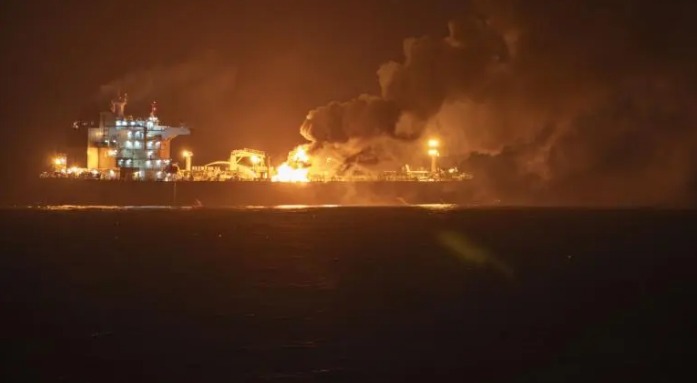
The AMOC, which helps maintain a mild climate in Europe, brings rain to the tropics, and stores CO₂, is expected to slow down and could even stop due to climate change.
A colossal storm system that freezes everything in its path, with temperatures plunging to -101°C; enormous hailstones striking Tokyo; gigantic tornadoes destroying Los Angeles; New York frozen in ice… In 2004, the Hollywood film The Day After Tomorrow, directed by Roland Emmerich, depicted the catastrophic consequences of a disruption in the Atlantic Ocean circulation, leading to a new ice age.
From a scientific perspective, this scenario is entirely unrealistic, both in terms of the scale of cooling and the timeframe: it would occur over decades or centuries, not just in a few days.
Nevertheless, the blockbuster addresses a threat that continues to concern scientists and spark intense debates: the risk of a collapse of the primary ocean circulation of the Atlantic. This Atlantic Meridional Overturning Circulation (AMOC) contributes significantly to maintaining a mild climate in Europe and regulating the temperature in North America.
In an open letter published in October 2024 and addressed to the leaders of the Nordic Council of Ministers, 44 climate scientists warned of the risk of a collapse of the AMOC, with « irreversible » and « devastating » effects, particularly for Nordic countries but also for the entire world. Several recent studies, they point out, suggest that the Intergovernmental Panel on Climate Change (IPCC) has « greatly underestimated » this threat and that crossing a tipping point is a « serious possibility within the next few decades. »
Vicious Circle
« It would then be very difficult to prevent a complete collapse of the AMOC, » said oceanographer and climatologist Stefan Rahmstorf from the Potsdam Institute for Climate Impact Research, one of the letter’s signatories. « This collapse will probably not be completed until the end of the century or later, but severe repercussions will already be felt along the way. »
The AMOC transports warm, salty water from the equator to the poles, off the American coasts, then to Northern and Western Europe, and up to the Arctic seas bordering Greenland and Scandinavia. There, these surface currents cool, become heavier, and « sink to depths of up to 1,000 meters, » before traveling southward deeper into the Southern Hemisphere, explained Didier Swingedouw, a researcher at the CNRS in Bordeaux and another letter signatory. This circulation is one of the largest heat transport systems on the planet: with a flow of 18 million cubic meters per second (about a hundred times the Amazon), it transfers 1 petawatt of energy, equivalent to the power of a million nuclear reactors. Beyond regulating the climate in high latitudes, the AMOC also affects rainfall patterns in the tropics, helps store CO₂ at depth, and transports nutrients vital for marine biodiversity.
But this circulation is expected to slow down, or could even stop, due to climate change. First, because surface waters are becoming warmer and less dense. Then, the melting of Greenland and the increase in precipitation add more freshwater into the Atlantic, reducing the salinity and thus the density of the water. « Convection, that is, the mixing of waters, becomes more complicated, and it might no longer be possible to form dense deep waters. So, sooner or later, the AMOC will slow down, » explained Julie Deshayes, a research director at the Pierre-Simon Laplace Institute in Paris. In this vicious circle, a threshold could be crossed beyond which the AMOC would not be able to return to its original state and would eventually stop. « A catastrophe within a catastrophe, » summarized Julie Deshayes.
« A Catastrophe Within a Catastrophe »
This tipping point would have disastrous consequences. « A catastrophe within the catastrophe of climate change, » summarized Julie Deshayes. Temperatures could drop by several degrees in certain areas of North America and Northern Europe, even though this cooling would be tempered by global warming. « France would cool by about 1°C during the 2075-2100 period, compared to the 2020-2025 average, in the case of an AMOC collapse beginning in 2070 and continuing with the current warming trajectory, » explained Henk Dijkstra, one of the authors of a recent study on the AMOC. Conversely, temperatures would rise in the Southern Hemisphere. « The increased contrast between temperatures would fuel more extreme events, » such as torrential rains, storms, or extreme droughts, warned Stefan Rahmstorf. The viability of agriculture in the northwest of the Old Continent would also be threatened.
A major food crisis would unfold in the tropics. African and South American monsoons would shift southward by 500 to 1,000 kilometers, leading to a 30% decrease in rainfall in the Sahel, affecting staple crop production. « Tens of millions of people would face food insecurity, which could significantly increase migration pressure, » warned Didier Swingedouw. Asian monsoons could also diminish. Finally, a stoppage of the AMOC would reduce the absorption of carbon dioxide by the oceans, worsening global warming and accelerating sea-level rise.
Can Such a Scenario Occur, and When?
In its latest report, published in 2021, the IPCC concluded, with « moderate confidence, » that a sudden collapse will not occur before 2100. However, it is « very likely » that the AMOC will decrease by a third on average during the 21st century, with a « range of -3% to -72%, depending on models and simulations, » said Didier Swingedouw. Scientists have « low confidence » in the extent and speed of the expected slowdown, but they also note that the AMOC has already slowed in recent decades. This circulation could be at its lowest level in a thousand years. But direct observations measuring the strength of the AMOC are scarce and have only existed since 2004, a « too short period to distinguish the signature of climate change from natural variability, » reminded Julie Deshayes.
A « Very Complex » Issue
Climate models have « underestimated the risk, » says Stefan Rahmstorf, because they do not include the melting of Greenland’s ice. As a result, they fail to see what he believes is the main evidence of AMOC slowing since the 1950s: the development of a cold zone southeast of Greenland, known to Anglo-Saxons as the « cold blob. » « This region is the only place on Earth that has cooled since the end of the 19th century, while the rest of the planet has warmed, » he argued



